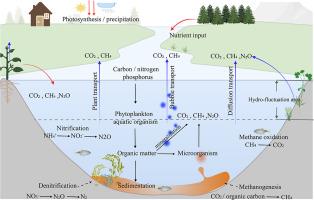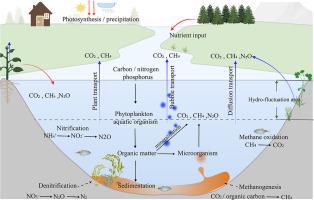Global inland water greenhouse gas (GHG) geographical patterns and escape mechanisms under different water level
IF 11.4
1区 环境科学与生态学
Q1 ENGINEERING, ENVIRONMENTAL
引用次数: 0
Abstract
Inland water ecosystems are unique, whereby water level changes can lead to variance in greenhouse gas (GHG) emissions. The GHG circulation intensity of inland waterbodies is high, so different water depths affect the temperature sensitivity of greenhouse gases, and have different cooling effects on CO2 storage and warming effects on CH4 emissions, being a typical GHG conversion channel. This study systematically reveals geographical GHG emission patterns from inland waterbodies and GHG impact mechanisms from regional waterbodies. Special emphasis is also paid to compounded environmental impact changes on GHG emissions under water level regulations. Additionally, we explore how increases in primary productivity can convert aquatic ecosystems from CO2 sources to CO2 sinks. However, GHG formation and emissions under ecological reservoir water level fluctuations in flood-ebb zones, intertidal tidal zones, wetlands, and lacustrine systems remain uncertain compared with those under natural hydrological conditions. Therefore, mechanisms that control GHG exchange and production processes under water level changes must first be determined, especially regarding post flood hydrological-based drying effects on GHG flux at the water-air interface. Finally, we recommend instituting environmental management and water-level control measures to reduce GHG emissions, which are favorable for minimizing GHG flux while protecting ecosystem functions and biodiversity.


不同水位下全球内陆水域温室气体(GHG)的地理格局和逃逸机制
内陆水域生态系统具有独特性,水位变化可导致温室气体(GHG)排放量的变化。内陆水体的温室气体循环强度高,因此不同的水深会影响温室气体的温度敏感性,并对二氧化碳的储存产生不同的冷却效应,对甲烷的排放产生不同的升温效应,是典型的温室气体转换通道。本研究系统地揭示了内陆水体温室气体的地理排放模式和区域水体的温室气体影响机制。研究还特别强调了水位调节对温室气体排放的复合环境影响变化。此外,我们还探讨了初级生产力的提高如何将水生生态系统从二氧化碳源转变为二氧化碳汇。然而,与自然水文条件下的温室气体形成和排放相比,洪水-低潮带、潮间带、湿地和湖泊系统中生态水库水位波动下的温室气体形成和排放仍不确定。因此,必须首先确定水位变化下温室气体交换和生成过程的控制机制,尤其是洪水后水文干燥对水气界面温室气体通量的影响。最后,我们建议采取环境管理和水位控制措施来减少温室气体排放,这有利于在保护生态系统功能和生物多样性的同时最大限度地减少温室气体通量。
本文章由计算机程序翻译,如有差异,请以英文原文为准。
求助全文
约1分钟内获得全文
求助全文
来源期刊

Water Research
环境科学-工程:环境
CiteScore
20.80
自引率
9.40%
发文量
1307
审稿时长
38 days
期刊介绍:
Water Research, along with its open access companion journal Water Research X, serves as a platform for publishing original research papers covering various aspects of the science and technology related to the anthropogenic water cycle, water quality, and its management worldwide. The audience targeted by the journal comprises biologists, chemical engineers, chemists, civil engineers, environmental engineers, limnologists, and microbiologists. The scope of the journal include:
•Treatment processes for water and wastewaters (municipal, agricultural, industrial, and on-site treatment), including resource recovery and residuals management;
•Urban hydrology including sewer systems, stormwater management, and green infrastructure;
•Drinking water treatment and distribution;
•Potable and non-potable water reuse;
•Sanitation, public health, and risk assessment;
•Anaerobic digestion, solid and hazardous waste management, including source characterization and the effects and control of leachates and gaseous emissions;
•Contaminants (chemical, microbial, anthropogenic particles such as nanoparticles or microplastics) and related water quality sensing, monitoring, fate, and assessment;
•Anthropogenic impacts on inland, tidal, coastal and urban waters, focusing on surface and ground waters, and point and non-point sources of pollution;
•Environmental restoration, linked to surface water, groundwater and groundwater remediation;
•Analysis of the interfaces between sediments and water, and between water and atmosphere, focusing specifically on anthropogenic impacts;
•Mathematical modelling, systems analysis, machine learning, and beneficial use of big data related to the anthropogenic water cycle;
•Socio-economic, policy, and regulations studies.
 求助内容:
求助内容: 应助结果提醒方式:
应助结果提醒方式:


